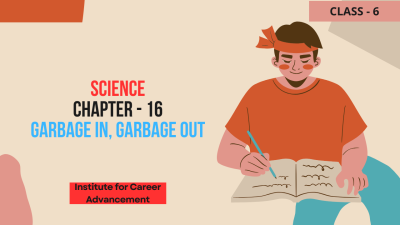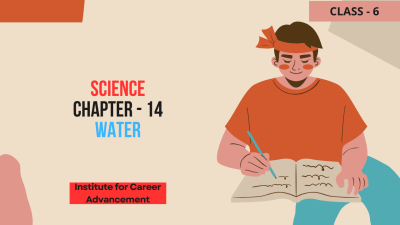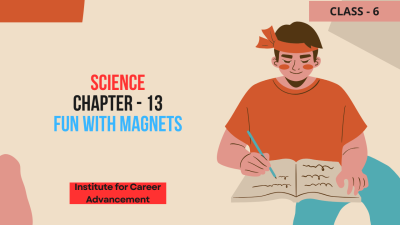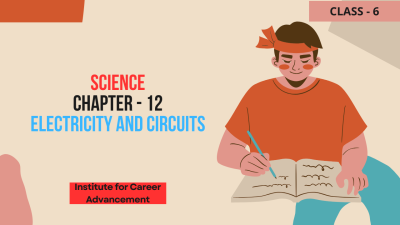Courses


 Compare
Compare
"Garbage In, Garbage Out" in Class 6 typically focuses on waste management and environmental stewardship. This topic explores the concepts of waste generation, its impact on the environment, and the importance of waste reduction and recycling. Students learn about different types of waste, their sources, and the consequences of improper disposal. Practical aspects often include discussions on recycling methods, waste segregation, and the role of individuals and communities in sustainable waste management practices. Overall, the course aims to instill awareness and responsibility regarding waste management and its implications for a cleaner and healthier environment. ক্লাস 6-এ "গার্বেজ ইন, গার্বেজ আউট" সাধারণত বর্জ্য ব্যবস্থাপনা এবং পরিবেশগত স্টুয়ার্ডশিপের উপর ফোকাস করে। এই বিষয় বর্জ্য উৎপাদনের ধারণা, পরিবেশের উপর এর প্রভাব এবং বর্জ্য হ্রাস ও পুনর্ব্যবহার করার গুরুত্ব অন্বেষণ করে। শিক্ষার্থীরা বিভিন্ন ধরণের বর্জ্য, তাদের উত্স এবং অনুপযুক্ত নিষ্পত্তির পরিণতি সম্পর্কে শিখে। ব্যবহারিক দিকগুলির মধ্যে প্রায়ই পুনর্ব্যবহার পদ্ধতি, বর্জ্য পৃথকীকরণ এবং টেকসই বর্জ্য ব্যবস্থাপনা অনুশীলনে ব্যক্তি ও সম্প্রদায়ের ভূমিকা নিয়ে আলোচনা অন্তর্ভুক্ত থাকে। সামগ্রিকভাবে, কোর্সটির লক্ষ্য বর্জ্য ব্যবস্থাপনা এবং একটি পরিষ্কার এবং স্বাস্থ্যকর পরিবেশের জন্য এর প্রভাব সম্পর্কে সচেতনতা ও দায়িত্ববোধ জাগানো।
₹599
0 Lessons
Hours

 Compare
Compare
"Air Around Us" in Class 6 Science is a fundamental exploration of the composition, properties, and importance of the Earth's atmosphere. Students delve into understanding the gases that make up air, the dynamics of air movement, and its significance for life on Earth. Topics typically include the composition of air, the role of air in weather patterns, the effects of air pollution, and methods for air quality monitoring. Practical activities often involve experiments to demonstrate air properties and explore atmospheric phenomena. Overall, the course aims to foster an appreciation for the role of air in the environment and promote awareness of its conservation and quality. ক্লাস 6 বিজ্ঞানের "আমাদের চারপাশে বায়ু" হল পৃথিবীর বায়ুমণ্ডলের গঠন, বৈশিষ্ট্য এবং গুরুত্বের একটি মৌলিক অনুসন্ধান। শিক্ষার্থীরা বায়ু তৈরি করে এমন গ্যাস, বায়ু চলাচলের গতিশীলতা এবং পৃথিবীতে জীবনের জন্য এর তাৎপর্য বোঝার চেষ্টা করে। বিষয়গুলি সাধারণত বায়ুর সংমিশ্রণ, আবহাওয়ার ধরণগুলিতে বায়ুর ভূমিকা, বায়ু দূষণের প্রভাব এবং বায়ুর গুণমান পর্যবেক্ষণের পদ্ধতিগুলি অন্তর্ভুক্ত করে। ব্যবহারিক ক্রিয়াকলাপগুলি প্রায়শই বায়ুর বৈশিষ্ট্যগুলি প্রদর্শন এবং বায়ুমণ্ডলীয় ঘটনা অন্বেষণ করার জন্য পরীক্ষা-নিরীক্ষার সাথে জড়িত। সামগ্রিকভাবে, কোর্সটির লক্ষ্য পরিবেশে বায়ুর ভূমিকার জন্য একটি উপলব্ধি বৃদ্ধি করা এবং এর সংরক্ষণ ও গুণমান সম্পর্কে সচেতনতা বৃদ্ধি করা।
₹599
0 Lessons
Hours

 Compare
Compare
"Water" in Class 6 Science covers the essential properties, distribution, and importance of water on Earth. Students learn about the physical and chemical properties of water, its role in the environment, and its significance for life. Topics typically include the water cycle, sources of water, conservation methods, and the impact of human activities on water resources. Practical activities often involve understanding water purification, testing water quality, and exploring the global distribution of water. Overall, the course aims to foster an appreciation for water as a vital natural resource and promote awareness of its conservation and sustainable use. ক্লাস 6 বিজ্ঞানে "জল" পৃথিবীতে পানির প্রয়োজনীয় বৈশিষ্ট্য, বিতরণ এবং গুরুত্বকে কভার করে। শিক্ষার্থীরা পানির ভৌত ও রাসায়নিক বৈশিষ্ট্য, পরিবেশে এর ভূমিকা এবং জীবনের জন্য এর তাৎপর্য সম্পর্কে শেখে। বিষয়গুলি সাধারণত জল চক্র, জলের উত্স, সংরক্ষণ পদ্ধতি এবং জল সম্পদের উপর মানুষের কার্যকলাপের প্রভাব অন্তর্ভুক্ত করে। ব্যবহারিক ক্রিয়াকলাপে প্রায়শই জল পরিশোধন বোঝা, জলের গুণমান পরীক্ষা করা এবং জলের বৈশ্বিক বন্টন অন্বেষণ করা জড়িত। সামগ্রিকভাবে, এই কোর্সের লক্ষ্য একটি অত্যাবশ্যক প্রাকৃতিক সম্পদ হিসাবে জলের প্রতি উপলব্ধি বৃদ্ধি করা এবং এর সংরক্ষণ ও টেকসই ব্যবহারের বিষয়ে সচেতনতা বৃদ্ধি করা।
₹599
0 Lessons
Hours

 Compare
Compare
"Fun with Magnets" in Class 6 Science introduces students to the fascinating world of magnets and magnetic fields. This topic covers fundamental concepts related to magnets, their properties, and their practical applications. Students learn about different types of magnets (permanent and temporary), how magnets attract and repel each other, and how magnetic fields interact with magnetic materials. Practical activities include experimenting with magnetism, observing magnetic forces, and exploring the use of magnets in everyday objects and technologies. Overall, the course aims to spark curiosity, deepen understanding of magnetism, and highlight its importance in various scientific and technological fields. ক্লাস 6 বিজ্ঞানে "ম্যাগনেটের সাথে মজা" ছাত্রদের চুম্বক এবং চৌম্বক ক্ষেত্রের আকর্ষণীয় জগতের সাথে পরিচয় করিয়ে দেয়। এই বিষয়টি চুম্বক, তাদের বৈশিষ্ট্য এবং তাদের ব্যবহারিক প্রয়োগ সম্পর্কিত মৌলিক ধারণাগুলিকে কভার করে। শিক্ষার্থীরা বিভিন্ন ধরণের চুম্বক (স্থায়ী এবং অস্থায়ী), কীভাবে চুম্বক একে অপরকে আকর্ষণ করে এবং বিকর্ষণ করে এবং কীভাবে চৌম্বকীয় পদার্থের সাথে চৌম্বক ক্ষেত্রগুলি যোগাযোগ করে সে সম্পর্কে শিখে। ব্যবহারিক ক্রিয়াকলাপের মধ্যে রয়েছে চুম্বকত্ব নিয়ে পরীক্ষা করা, চৌম্বকীয় শক্তি পর্যবেক্ষণ করা এবং দৈনন্দিন বস্তু ও প্রযুক্তিতে চুম্বকের ব্যবহার অন্বেষণ করা। সামগ্রিকভাবে, কোর্সের লক্ষ্য কৌতূহল জাগানো, চুম্বকত্ব সম্পর্কে গভীর বোঝাপড়া করা এবং বিভিন্ন বৈজ্ঞানিক ও প্রযুক্তিগত ক্ষেত্রে এর গুরুত্ব তুলে ধরা।
₹599
0 Lessons
Hours

 Compare
Compare
"Electricity and Circuits" in Class 6 Science introduces students to the basics of electricity, electrical circuits, and their applications. Students learn about the properties of electricity, how it is generated, and its role in various devices. They explore different components of an electrical circuit, including conductors, insulators, switches, and bulbs. Practical activities involve assembling simple circuits, understanding circuit diagrams, and experimenting with series and parallel circuits. The topic also covers safety precautions when dealing with electricity and emphasizes the importance of conservation and responsible use of electrical energy. Overall, the course aims to build a foundational understanding of electricity and circuits, preparing students to comprehend their significance in modern technology and everyday life. ক্লাস 6 বিজ্ঞানের "বিদ্যুত এবং সার্কিট" শিক্ষার্থীদের বিদ্যুৎ, বৈদ্যুতিক সার্কিট এবং তাদের প্রয়োগের মৌলিক বিষয়গুলির সাথে পরিচয় করিয়ে দেয়। শিক্ষার্থীরা বিদ্যুতের বৈশিষ্ট্য, এটি কীভাবে উৎপন্ন হয় এবং বিভিন্ন ডিভাইসে এর ভূমিকা সম্পর্কে শিখে। তারা কন্ডাক্টর, ইনসুলেটর, সুইচ এবং বাল্ব সহ বৈদ্যুতিক সার্কিটের বিভিন্ন উপাদান অন্বেষণ করে। ব্যবহারিক ক্রিয়াকলাপের মধ্যে রয়েছে সাধারণ সার্কিট একত্রিত করা, সার্কিট ডায়াগ্রাম বোঝা এবং সিরিজ এবং সমান্তরাল সার্কিট নিয়ে পরীক্ষা করা। বিষয়টি বিদ্যুতের সাথে কাজ করার সময় সুরক্ষা সতর্কতাগুলিও কভার করে এবং সংরক্ষণের গুরুত্ব এবং বৈদ্যুতিক শক্তির দায়িত্বশীল ব্যবহারের উপর জোর দেয়। সামগ্রিকভাবে, কোর্সটির লক্ষ্য হল বিদ্যুৎ এবং সার্কিট সম্পর্কে একটি ভিত্তিগত বোঝাপড়া তৈরি করা, শিক্ষার্থীদের আধুনিক প্রযুক্তি এবং দৈনন্দিন জীবনে তাদের তাৎপর্য বোঝার জন্য প্রস্তুত করা।
₹599
0 Lessons
Hours

 Compare
Compare
"Light, Shadow, and Reflection" in Class 6 Science explores the properties and behaviors of light, focusing on its interaction with objects to create shadows and reflections. Students learn about the nature of light, how it travels in straight lines, and the formation of shadows when light is blocked by opaque objects. They also study the principles of reflection, including regular and diffuse reflection, and discover how light behaves when it strikes smooth and rough surfaces. Practical applications of reflection in mirrors and optical instruments are explored, along with hands-on activities to demonstrate these phenomena. Overall, the topic provides a foundational understanding of light and its effects, preparing students to appreciate its role in everyday life and scientific applications. ক্লাস 6-এ "আলো, ছায়া এবং প্রতিফলন" আলোর বৈশিষ্ট্য এবং আচরণগুলি অন্বেষণ করে, ছায়া এবং প্রতিফলন তৈরি করতে বস্তুর সাথে এর মিথস্ক্রিয়ায় ফোকাস করে। শিক্ষার্থীরা আলোর প্রকৃতি, কীভাবে এটি সরলরেখায় ভ্রমণ করে এবং আলো অস্বচ্ছ বস্তু দ্বারা অবরুদ্ধ হলে ছায়ার গঠন সম্পর্কে শিখে। তারা নিয়মিত এবং ছড়িয়ে পড়া প্রতিফলন সহ প্রতিফলনের নীতিগুলিও অধ্যয়ন করে এবং আবিষ্কার করে যে আলো মসৃণ এবং রুক্ষ পৃষ্ঠগুলিতে আঘাত করলে কীভাবে আচরণ করে। আয়না এবং অপটিক্যাল যন্ত্রগুলিতে প্রতিফলনের ব্যবহারিক প্রয়োগগুলি এই ঘটনাগুলি প্রদর্শনের জন্য হ্যান্ড-অন ক্রিয়াকলাপগুলির সাথে অন্বেষণ করা হয়। সামগ্রিকভাবে, বিষয়টি আলো এবং এর প্রভাব সম্পর্কে একটি মৌলিক ধারণা প্রদান করে, যা শিক্ষার্থীদের দৈনন্দিন জীবনে এবং বৈজ্ঞানিক প্রয়োগে এর ভূমিকার প্রশংসা করতে প্রস্তুত করে।
₹599
0 Lessons
Hours

 Compare
Compare
The movement of any object with respect to time is known as motion. The path covered by an object is known as distance. Motion in a straight line is called rectilinear motion, while motion in circular paths is known as circular motion. Different means of transport are used to travel from one place to another. সময়ের সাপেক্ষে যেকোনো বস্তুর গতিকে গতি বলে। একটি বস্তু দ্বারা আচ্ছাদিত পথ দূরত্ব হিসাবে পরিচিত। সরলরেখায় গতিকে বলা হয় রেকটিলাইনার মোশন, অন্যদিকে বৃত্তাকার পথে গতিকে বৃত্তাকার গতি বলা হয়। এক স্থান থেকে অন্য স্থানে যাতায়াতের জন্য বিভিন্ন পরিবহনের মাধ্যম ব্যবহার করা হয়।
₹599
0 Lessons
Hours

 Compare
Compare
An organism is simply defined as any living thing , ranging from microscopic bacteria to large elephants and everything in between. It can be observed that different types of plants and animals (living Organisms) can be found in different types of surroundings. একটি জীবকে সহজভাবে সংজ্ঞায়িত করা হয় যেকোন জীবিত জিনিস, মাইক্রোস্কোপিক ব্যাকটেরিয়া থেকে শুরু করে বড় হাতি এবং এর মধ্যে থাকা সবকিছু। এটি লক্ষ্য করা যায় যে বিভিন্ন ধরণের গাছপালা এবং প্রাণী (জীবন্ত প্রাণী) বিভিন্ন ধরণের পরিবেশে পাওয়া যায়।
₹599
0 Lessons
Hours

 Compare
Compare
Movement is the change in the position of a body part with respect to the whole body. It is one of the significant features of all living beings. নড়াচড়া হল পুরো শরীরের সাপেক্ষে একটি শরীরের অংশের অবস্থানের পরিবর্তন। এটি সমস্ত জীবের উল্লেখযোগ্য বৈশিষ্ট্যগুলির মধ্যে একটি।
₹599
0 Lessons
Hours